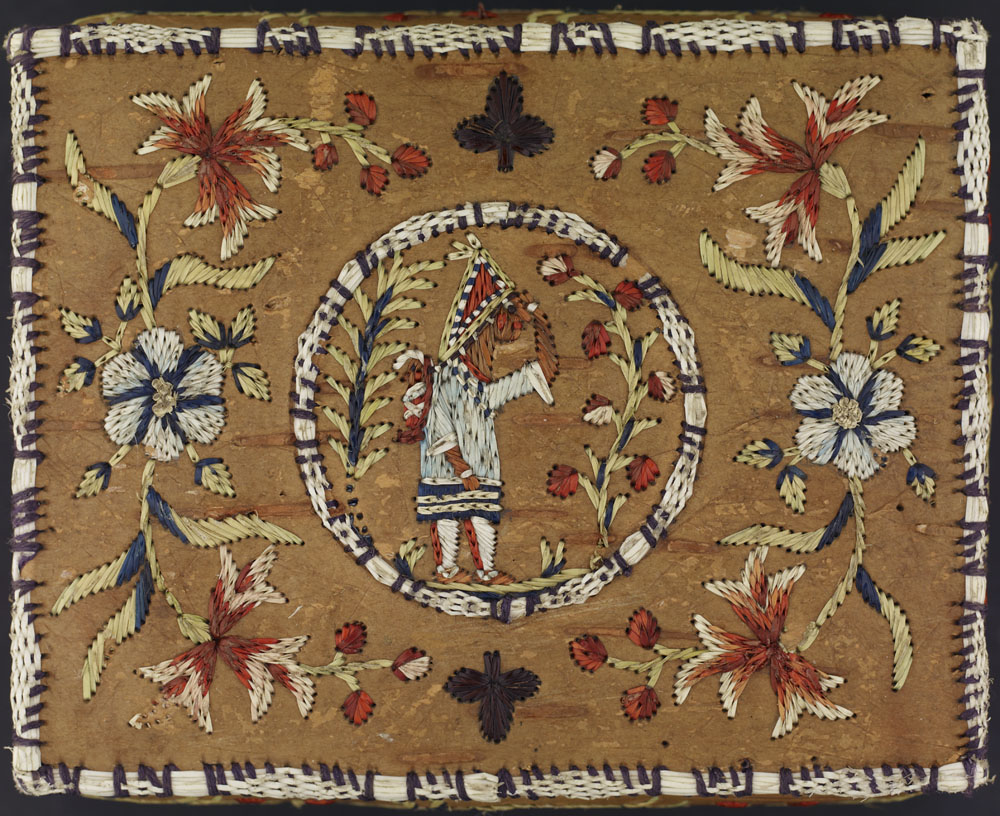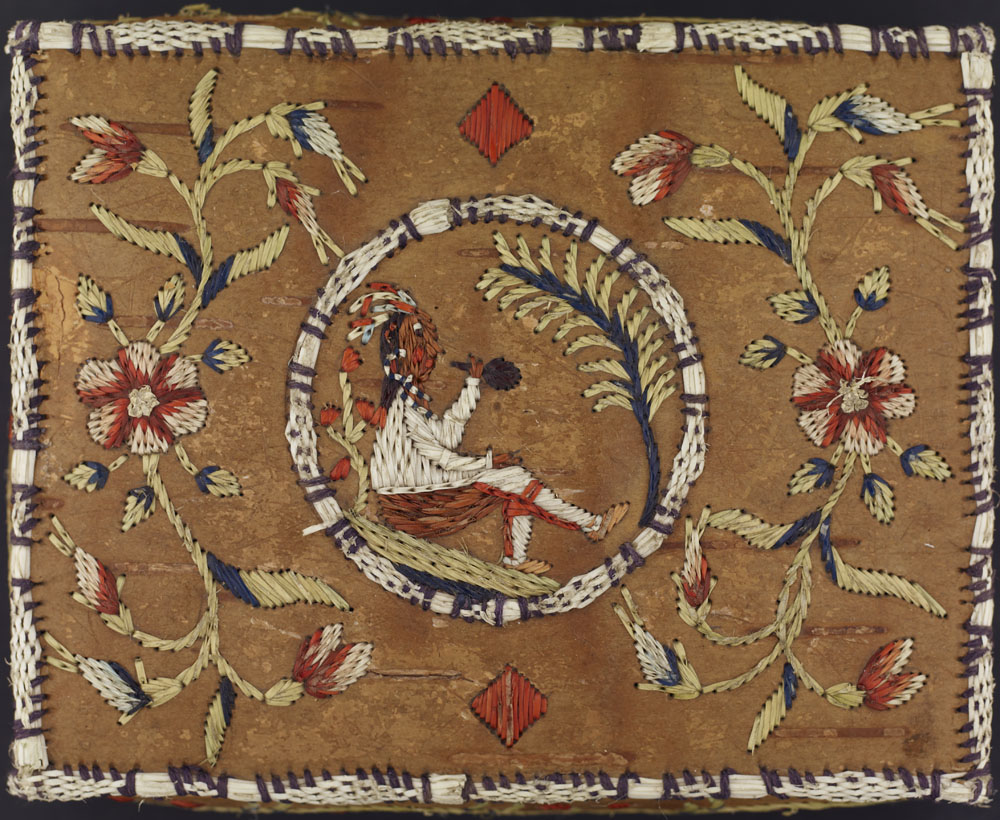by Vasanthi Pendakur and Elizabeth Kawenaa Montour

Birch bark box lid embroidered with diamonds playing cards suit symbol and a First Nations man smoking a pipe. (e010948522)
Birch bark boxes are extremely rare objects among the Library and Archives Canada collection. These boxes are three-dimensional and feature embroidered designs made with moose hair inserted through the pierced bark. The use of moose hair to decorate objects originated with First Nations before the arrival of the Europeans. The boxes in this set are similar to those created in convents by the Ursuline sisters of Québec and were probably made for sale to tourists in 18th-century Quebec. Boxes like these were popular souvenirs among the French elite and, later, the British military. These particular boxes were acquired by a military officer stationed in Niagara during the American War of Independence. According to the descriptive record, the boxes date from 1780–1800 and were collected by Henry Powell (died 1815), of the 53rd Regiment of Foot.

One side of a birch bark box. (e010948522_s6)
Upon review of the descriptive record and viewing the object in the collection, additional information would lead to the modification of the record to reflect the new information.
When creating a record for an archival item, a quality control officer uploads the information into the catalogue and ensures it is accurate, often working to confirm details with the archivist responsible for the particular holding. In this instance, the archivist confirmed the exact materials used to construct and decorate the box: birch bark and moose hair.

Birch bark box lid embroidered with a spade playing card suit symbol and a First Nations man smoking a pipe. (e010948521)

Birch bark box lid embroidered with a clubs playing card suit symbol featuring a First Nations woman standing in profile, a child in cradleboard on her back. (e010948523)
The boxes in this set are identical in size, and all are made of birch bark and embroidered in moose hair. Though at first glance the embroidered designs look similar, each box features a unique pattern based on one of the playing card suits—hearts, diamonds, clubs or spades. Each box lid has two hearts, diamonds, spades or clubs embroidered on it. As well, each lid features a First Nations figure in profile inside a central circle: two lids feature men smoking pipes; one lid is of a man holding a bow and arrow; and a fourth lid is of a woman with a child in a cradleboard on her back. On each side of the circles are embroidered floral patterns of colourful blossoms, leaves and stems. The edges are trimmed with secured lengths of moose hair.

Birch bark box lid embroidered with a hearts playing card suit symbol featuring a First Nations man with bow and arrow standing in profile. (e010948520)
While researching this embroidery style, we discovered that a moose hair embroidered birch bark tray in the collections of the McCord Museum had the following description:
“In 1714, Mother St-Joseph, a [sic] Ursuline from Trois-Rivières, taught the art of embroidery on birch bark. Another Ursuline nun also made a major contribution: Mother Sainte-Marie-Madeleine (Anne Du Bos), who was born in Sillery in 1678, to a Huron-Wendat mother and a French father. According to her 1734 obituary, she devoted the final years of her life to teaching embroidery, in particular, embroidery with moose hair, which by 1720, was widely recognized as a refined and elegant form of needlework.”
The boxes in the LAC collection appear to be of a similar style.
Even after European supplies became more readily available, local materials continued to be used for the souvenir appeal. Both First Nations and nuns likely made these types of boxes for the tourism industry, hence the confusion over who ultimately might have made this set.
In the descriptive record, the archivist did note that the provenance of the set of boxes was not clear. Given that the style of these boxes was widespread, it is uncertain whether nuns, First Nations girls, or French women made the boxes. In the end, the description was revised to reflect the uncertainty as to the identity of those who created them. This was my introduction to how records can be improved and made more accessible through updated research. This example only scratches the surface of revising historic descriptions. Archivists are re-visiting descriptions created in the past to make them more accurate, but still have plenty of work ahead of them.
This blog is part of a series related to the Indigenous Documentary Heritage Initiatives. Learn how Library and Archives Canada (LAC) increases access to First Nations, Inuit and Métis Nation collections and supports communities in the preservation of Indigenous language recordings.
Vasanthi Pendakur is a former project manager with the Exhibitions and Online Content Division. She was responsible for researching and publishing LAC’s Flickr albums. Elizabeth Kawenaa Montour is an Indigenous research archivist with the Exhibitions and Online Content Division. She is responsible for researching and publishing Indigenous content blogs and Flickr albums.

![On the left of the graphic, Tatânga Mânî [Chief Walking Buffalo] [George McLean] in traditional regalia on horse. In the middle, Iggi and girl engaging in a “kunik”, a traditional greeting in Inuit culture. On the right, Maxime Marion, a Métis guide stands holding a rifle. In the background, there is a map of Upper and Lower Canada, and text from the Red River Settlement collection.](https://thediscoverblog.files.wordpress.com/2019/02/blog-banner-1.jpg)




















![Six small sketches of different types of icebergs in pale colours with the caption: “Vanille, fraise, framboise – boum, servez froid!” [Vanilla, strawberry, raspberry—boom, serve cold!]](https://thediscoverblog.files.wordpress.com/2019/08/e008444012.jpg)

















